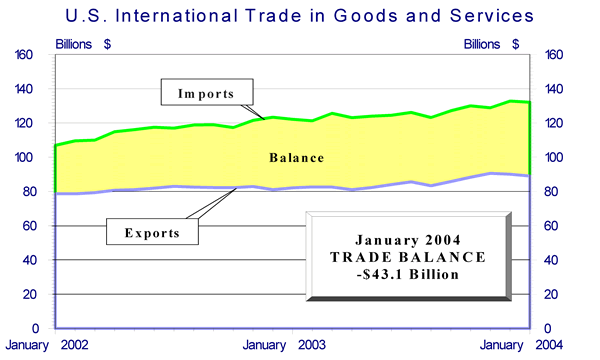Record Trade Deficit, "Blah blah blah," says the market.
Check out the image below, courtesy of the Dept. of Commerce. It shows a country that continues to consume more than it produces, yet whose currency rises on the news. Go figure. Why did the dollar go up when the fundamental numbers show the balance sheet of America getting worse? Who knows. The easy explanation--the one you'll read in the press--is that the U.S. is a bigger "growth" story than Europe. If you're talking about growing deficits, that's surely true. Let's look at just a few of the numbers from the report: *A January deficit of $43.1 billion--a new record *Imports at $132.1 billion, the second highest level ever *Exports of $89 billion, down 1.2% from December *Year over year, exports down 8.5% *Year over year, imports up 8.2% *Exports to Europe down $0.3 billion *Goods deficit with China, up $1.6 billion to $11.5 billion You may be wondering how the dollar can rise in the face of such stiff trade headwinds. After all, in order for the dollar to retain its value when the U.S. runs a deficit, investment flows back into the United States must match the size of the deficit. If not, the adjustment comes in the form of a weaker currency. For some reason, the Bureau of Economic Analysis has not published fourth quarter figures on the balance of payments, which shows exactly what foreign investment flows into the U.S. are. We can presume, because the dollar fell, that foreign purchases of U.S. assets were not enough to match the monthly trade deficits in goods and services.
 Going forward, though, what to expect? All things being equal, the dollar will find its "fair value," maybe not in a day, a week, or a month. But sooner rather than letter.
What's striking about this batch of data is that a weaker dollar is not helping U.S. exports on a net basis, especially in that place where it should be helping U.S. exporters most, Europe. I look around me, however, and I don't see Brits lining up to buy U.S.-made products that are cheaper now then they were a year ago. Software wasn't flying off the shelves. Nor were Brittany Spears CDs.
This leads me to believe that if a weaker dollar is really going to reduce the deficit, it will have to be because the price of imports in the U.S. is higher and Americans buy less (it's possible in theory, you know.) The rising price of imports in the U.S. will lower consumption.
And of course, if that happens, it means consumer retrenchment...and a slower economic growth--which certainly isn't good for the dollar either.
The hard truth is there's no way out of a weaker dollar adjustment. Try as you might, the math simply doesn't add up. It can be resisted, ignored, and mocked. But it can't be denied. And it will start showing up in the figures of foreign purchases of U.S. assets...if the government ever gets around to publishing them again (sort of like the PPI numbers.)
Going forward, though, what to expect? All things being equal, the dollar will find its "fair value," maybe not in a day, a week, or a month. But sooner rather than letter.
What's striking about this batch of data is that a weaker dollar is not helping U.S. exports on a net basis, especially in that place where it should be helping U.S. exporters most, Europe. I look around me, however, and I don't see Brits lining up to buy U.S.-made products that are cheaper now then they were a year ago. Software wasn't flying off the shelves. Nor were Brittany Spears CDs.
This leads me to believe that if a weaker dollar is really going to reduce the deficit, it will have to be because the price of imports in the U.S. is higher and Americans buy less (it's possible in theory, you know.) The rising price of imports in the U.S. will lower consumption.
And of course, if that happens, it means consumer retrenchment...and a slower economic growth--which certainly isn't good for the dollar either.
The hard truth is there's no way out of a weaker dollar adjustment. Try as you might, the math simply doesn't add up. It can be resisted, ignored, and mocked. But it can't be denied. And it will start showing up in the figures of foreign purchases of U.S. assets...if the government ever gets around to publishing them again (sort of like the PPI numbers.)

0 Comments:
Post a Comment
<< Home